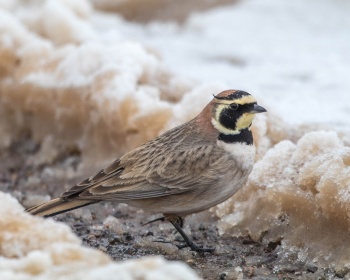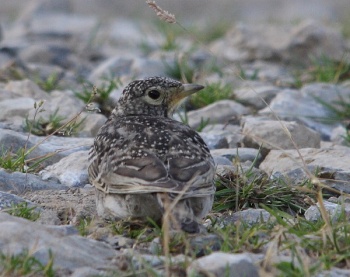Includes: Shore Lark
- Eremophila alpestris
Identification
14–17 cm (5½-6¾ in)
Adult
- Pale or dark brown upperparts.
- White underparts.
- White or pale yellow face and throat with black mask, collar, and ear tufts.
- Tail brown with white edges.
- Sexes are similar
Juvenile
- White-spotted brown upperparts, head and face
- White eyebrow
- No ear tufts
- White underparts with faintly spotted breast
Distribution

Photo © by baharro
Aladağlar National Park, Turkey; May 2006
Circumpolar; tundra, and south in mountain plateaux, plains and semi-deserts to the Atlas Mountains in northwest Africa, the Balkans in Europe, the Zagros and Himalaya in Asia, and the northernmost Andes in the Americas. Arctic populations are strongly migratory, while southern mountain populations are resident or short-distance altitudinal migrants.
Taxonomy
Complex. The currently accepted broad circumscription of a single species with 42 subspecies[1] has recently been shown to leave the species paraphyletic with respect to the closely related Temminck's Lark[2]; a split into six species (as arranged below) is likely to be accepted formally in the near future.
Of interest as the sole species of a diverse Old World family to have colonised the New World; a similar example in reverse is the Eurasian Wren.
Subspecies
- atlas group (Atlas Lark E. atlas; Atlas Mountains of north-west Africa; Monotypic.)
- E. a. atlas: Atlas Mountains of Morocco
- penicillata group (Caucasian Lark E. penicillata; mountains of south-east Europe, south-west Asia; 5 subspecies)
- E. a. balcanica: mountains of south-eastern Europe (Romania, Bulgaria, former Yugoslavia, and northern Greece)
- E. a. kumerloevei: west and central Asia Minor
- E. a. bicornis: Lebanon and south-western Syria
- E. a. penicillata: mountains of eastern Asia Minor, the Caucasus and western Iran
- E. a. albigula: mountains of northern and eastern Iran to Pamirs, Afghanistan and western China
- longirostris group (Himalayan Lark E. longirostris; Sino-himalayan mountains; 7 subspecies)
- E. a. longirostris: north-western Himalayas
- E. a. teleschowi: mountains of western China (extreme south-eastern Xinjiang)
- E. a. argalea: western China (extreme sw Xinjiang) to northwestern India (Kashmir to Ladakh)
- E. a. elwesi: western China (southern Qinghai and southern Tibet) to northern Sikkim
- E. a. khamensis: south-western China (Kham region of western and southern Sichuan)
- E. a. nigrifrons: western China (Kokonor to western Gansu)
- E. a. przewalskii: western China (north-western Qinghai)
- flava group (Shore Lark E. flava; arctic Eurasia; monotypic)
- E. a. flava: arctic Eurasia
- brandti group (Steppe Lark E. brandti; central Asia; monotypic)
- alpestris group (Horned Lark E. alpestris; Americas; 27 subspecies)
- E. a. hoyti: arctic coast of North America to southern Canada; winters to northern US
- E. a. alpestris: arctic north-eastern Canada to Newfoundland; winters coastal south-eastern US
- E. a. praticola: south-eastern Canada to central and east-central US
- E. a. giraudi: coastal prairie region of south-eastern Texas to eastern Mexico (north-eastern Tamaulipas)
- E. a. arcticola: north Alaska to mountains of British Columbia and northern Washington
- E. a. alpina: arctic-alpine summits of north-western US (Mount Rainier and Mount St. Helens)
- E. a. leucolaema: southern Canada to south-western US and north-western Texas; winters north-western Mexico
- E. a. enthymia: great Plains of central Canada to central US; winters northern Mexico
- E. a. merrilli: eastern slope of Cascades and adjacent lowlands from British Columbia to north-eastern California
- E. a. lamprochroma: south-eastern Oregon to south-western Idaho, north-eastern California and western Nevada
- E. a. utahensis: south-central Idaho to east-central Nevada and west-central Utah
- E. a. ammophila: deserts of south-western Nevada and south-eastern California; winters north-western Mexico
- E. a. leucansiptila: Colorado Desert (south-western Nevada, western Arizona, north-eastern Baja California and north-western Sonora)
- E. a. occidentalis: northern and central Arizona to north-central New Mexico; winters northern Mexico
- E. a. strigata: humid coastal belt of south-western British Columbia and north-western US west of the Cascades
- E. a. sierrae: mountains of north-eastern California (southern Cascades and northern Sierra Nevada)
- E. a. rubea: central California (Sacramento Valley)
- E. a. actia: coastal range of southern California (Humboldt Co.) to northern Baja California
- E. a. insularis: channel Islands (off southern California)
- E. a. adusta: south Arizona (south of Tucson) to extreme south-western New Mexico and northern Sonora
- E. a. enertera: west-central Baja California and coastal islands southern of Magdalena Bay
- E. a. aphrasta: north-western Mexico (Chihuahua and Durango)
- E. a. lactea: north-eastern Mexico (Coahuila)
- E. a. diaphora: north-eastern Mexico (south-eastern Coahuila to southern Tamaulipas, Hidalgo and north-eastern Puebla)
- E. a. chrysolaema: southern Mexican Plateau (Jalisco to Michoacán, Puebla and Veracruz)
- E. a. oaxacae: southern Mexico (east Oaxaca)
- E. a. peregrina: eastern Andes of Colombia
Habitat
Arctic and alpine tundra, plains, fields, and beaches.
Behaviour
Diet
Adults' diet includes weed and grass seeds; insects are fed to the young.
Vocalisation
References
- Clements, J. F., T. S. Schulenberg, M. J. Iliff, D. Roberson, T. A. Fredericks, B. L. Sullivan, and C. L. Wood. 2018. The eBird/Clements checklist of birds of the world: v2018. Downloaded from http://www.birds.cornell.edu/clementschecklist/download/
- Drovetski, S. V., Raković, M., Semenov, G., Fadeev, I. V., & Red'kin, Y. A. (2014). Limited phylogeographic signal in sex-linked and autosomal loci despite geographically, ecologically, and phenotypically concordant structure of mtDNA variation in the Holarctic avian genus Eremophila. PLoS ONE 9 (1): e87570.
- Birdforum thread discussing taxonomy of Horned Larks (post #20 et seq. for recent research)
Recommended Citation
- BirdForum Opus contributors. (2024) Horned Lark. In: BirdForum, the forum for wild birds and birding. Retrieved 24 April 2024 from https://www.birdforum.net/opus/Horned_Lark
External Links
GSearch checked for 2020 platform.








